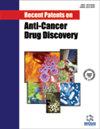Matrine Enhances the Antitumor Efficacy of Chidamide in CTCL by Promoting Apoptosis
IF 4.1
4区 医学
Q3 ONCOLOGY
Recent patents on anti-cancer drug discovery
Pub Date : 2024-04-04
DOI:10.2174/0115748928289036240318040756
引用次数: 0
Abstract
Background: Cutaneous T-cell Lymphoma (CTCL) is a rare group of non-Hodgkin lymphoma originating from the skin, which is characterized by T-cell lymphoproliferative disorders. Chidamide, a Chinese original antineoplastic agent with independent intellectual property rights, and matrine, an extract of Chinese herbal medicine, both have been reported to exert effects on the treatment of tumors individually. However, chidamide combined with matrine has not been tested for the treatment of CTCL. Methods: Both HH and Hut78 CTCL cell lines were treated with chidamide (0.4 μmol/L), matrine (0.6 g/L), or chidamide combined with matrine for 24, 48, and 72 h. Cell viability was estimated by MTS assay at each time point. Flow cytometry was then conducted to detect cell apoptosis. The exact mechanism of chidamide combined with matrine on CTCL cells was detected by Western blotting and further validated in xenograft models of NOD/SCID mice. Results and Discussion: Compared to the single drug, chidamide combined with matrine showed a more significant effect on proliferation inhibition and apoptosis induction on CTCL cells both in vitro and in vivo. The results from the in vitro and in vivo studies suggested that matrine could enhance the anti-tumor effect of chidamide by increasing the protein expression of cleaved caspase- 3 and decreasing the expression of E-cadherin, NF-κB, p-Bad, and Bcl-2 to activate apoptosis. Conclusion: Our data have demonstrated chidamide combined with matrine to exhibit elevated antitumor activity in both CTCL cells and xenograft models of NOD/SCID mice, which may be a potential treatment option for CTCL.马特林通过促进细胞凋亡增强了千达酰胺对CTCL的抗肿瘤疗效
背景:皮肤 T 细胞淋巴瘤(CTCL皮肤T细胞淋巴瘤(CTCL)是一类罕见的起源于皮肤的非霍奇金淋巴瘤,以T细胞淋巴增生性疾病为特征。据报道,具有自主知识产权的中国原创抗肿瘤药物--千黛胺和中药提取物--麻黄碱都具有单独治疗肿瘤的作用。然而,千金藤与马钱子碱联合治疗 CTCL 的试验尚未进行。研究方法HH和Hut78 CTCL细胞株分别用千达酰胺(0.4 μmol/L)、马钱子碱(0.6 g/L)或千达酰胺联合马钱子碱处理24、48和72小时。然后进行流式细胞术检测细胞凋亡。通过 Western 印迹法检测了 chidamide 与 matrine 联用对 CTCL 细胞的确切作用机制,并在 NOD/SCID 小鼠的异种移植模型中进行了进一步验证。结果与讨论:与单一药物相比,千达酰胺联合马钱子碱对CTCL细胞的体外和体内增殖抑制和凋亡诱导作用更为显著。体外和体内研究结果表明,马替林可通过增加裂解的 Caspase- 3 蛋白表达,降低 E-cadherin、NF-κB、p-Bad 和 Bcl-2 的表达来激活细胞凋亡,从而增强 chidamide 的抗肿瘤作用。结论我们的数据表明,在 CTCL 细胞和 NOD/SCID 小鼠异种移植模型中,氯达酰胺与马钱子碱联合使用可显示出更强的抗肿瘤活性,这可能是治疗 CTCL 的一种潜在选择。
本文章由计算机程序翻译,如有差异,请以英文原文为准。
求助全文
约1分钟内获得全文
求助全文
来源期刊
CiteScore
4.50
自引率
7.10%
发文量
55
审稿时长
3 months
期刊介绍:
Aims & Scope
Recent Patents on Anti-Cancer Drug Discovery publishes review and research articles that reflect or deal with studies in relation to a patent, application of reported patents in a study, discussion of comparison of results regarding application of a given patent, etc., and also guest edited thematic issues on recent patents in the field of anti-cancer drug discovery e.g. on novel bioactive compounds, analogs, targets & predictive biomarkers & drug efficacy biomarkers. The journal also publishes book reviews of eBooks and books on anti-cancer drug discovery. A selection of important and recent patents on anti-cancer drug discovery is also included in the journal. The journal is essential reading for all researchers involved in anti-cancer drug design and discovery. The journal also covers recent research (where patents have been registered) in fast emerging therapeutic areas/targets & therapeutic agents related to anti-cancer drug discovery.

 求助内容:
求助内容: 应助结果提醒方式:
应助结果提醒方式:


